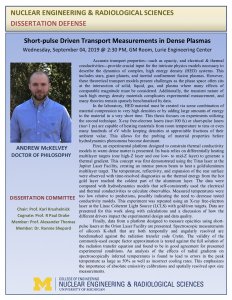Presented By: Nuclear Engineering & Radiological Sciences
PhD Defense: Andrew McKelvey
Short-pulse Driven Transport Measurements in Dense Plasmas

Title: Short-pulse Driven Transport Measurements in Dense Plasmas
Chair: Prof. Karl Krushelnick
Abstract: Accurate transport properties---such as opacity, and electrical & thermal conductivities---provide crucial input for the intricate physics models necessary to describe the dynamics of complex, high energy density (HED) systems. This includes stars, giant planets, and inertial confinement fusion plasmas. However, these theoretical transport models present challenges as the phase space often sits at the intersection of solid, liquid, gas, and plasma where many effects of comparable magnitude must be considered. Additionally, the transient nature of such high energy density materials complicates experimental measurement, and many theories remain sparsely benchmarked by data.
In the laboratory, HED material must be created via some combination of material compression to very high densities or by adding large amounts of energy to the material in a very short time. This thesis focuses on experiments utilizing the second technique. X-ray free-electron lasers (tau<100 fs) or short-pulse lasers (tau<1 ps) are capable of heating materials from room temperature to tens or even many hundreds of eV while keeping densities at appreciable fractions of their ambient value. This allows for the probing of material properties before hydrodynamics phenomena become dominant.
First, an experimental platform designed to constrain thermal conductivity models in warm dense matter is presented. Its basis relies on differentially heating multilayer targets (one high-Z layer and one low- to mid-Z layer) to generate a thermal gradient. This concept was first demonstrated using the Titan laser at the Jupiter Laser Facility, creating an intense proton beam to heat a gold/aluminum multilayer target. The temperature, reflectivity, and expansion of the rear surface were observed with time-resolved diagnostics as the thermal energy from the hot gold layer reached the coldest part of the aluminum layer. The data were compared with hydrodynamics models that self-consistently used the electrical and thermal conductivities to calculate observables. Measured temperatures were too low relative to predictions, possibly indicating the need to decrease tested conductivity models. This experiment was repeated using an X-ray free-electron laser at the Linac Coherent Light Source (LCLS) with gold/iron targets. Data are presented for this work along with calculations and a discussion of how the different drivers impact the experimental design and data quality.
Finally, data from a platform designed to measure opacities using short- pulse lasers at the Orion Laser Facility are presented. Spectroscopic measurements of silicon's K-shell that are both temporally and angularly resolved are benchmarked against the radiation transfer code Cretin. The validity of the commonly-used escape factor approximation is tested against the full solution of the radiation transfer equation and found to be in good agreement for presented experimental conditions. An analysis of the effects of radial gradients on spectroscopically inferred temperatures is found to lead to errors in the peak temperature as large as 50% as well as incorrect cooling rates. This emphasizes the importance of absolute emissivity calibrations and spatially resolved spot size measurements.
Chair: Prof. Karl Krushelnick
Abstract: Accurate transport properties---such as opacity, and electrical & thermal conductivities---provide crucial input for the intricate physics models necessary to describe the dynamics of complex, high energy density (HED) systems. This includes stars, giant planets, and inertial confinement fusion plasmas. However, these theoretical transport models present challenges as the phase space often sits at the intersection of solid, liquid, gas, and plasma where many effects of comparable magnitude must be considered. Additionally, the transient nature of such high energy density materials complicates experimental measurement, and many theories remain sparsely benchmarked by data.
In the laboratory, HED material must be created via some combination of material compression to very high densities or by adding large amounts of energy to the material in a very short time. This thesis focuses on experiments utilizing the second technique. X-ray free-electron lasers (tau<100 fs) or short-pulse lasers (tau<1 ps) are capable of heating materials from room temperature to tens or even many hundreds of eV while keeping densities at appreciable fractions of their ambient value. This allows for the probing of material properties before hydrodynamics phenomena become dominant.
First, an experimental platform designed to constrain thermal conductivity models in warm dense matter is presented. Its basis relies on differentially heating multilayer targets (one high-Z layer and one low- to mid-Z layer) to generate a thermal gradient. This concept was first demonstrated using the Titan laser at the Jupiter Laser Facility, creating an intense proton beam to heat a gold/aluminum multilayer target. The temperature, reflectivity, and expansion of the rear surface were observed with time-resolved diagnostics as the thermal energy from the hot gold layer reached the coldest part of the aluminum layer. The data were compared with hydrodynamics models that self-consistently used the electrical and thermal conductivities to calculate observables. Measured temperatures were too low relative to predictions, possibly indicating the need to decrease tested conductivity models. This experiment was repeated using an X-ray free-electron laser at the Linac Coherent Light Source (LCLS) with gold/iron targets. Data are presented for this work along with calculations and a discussion of how the different drivers impact the experimental design and data quality.
Finally, data from a platform designed to measure opacities using short- pulse lasers at the Orion Laser Facility are presented. Spectroscopic measurements of silicon's K-shell that are both temporally and angularly resolved are benchmarked against the radiation transfer code Cretin. The validity of the commonly-used escape factor approximation is tested against the full solution of the radiation transfer equation and found to be in good agreement for presented experimental conditions. An analysis of the effects of radial gradients on spectroscopically inferred temperatures is found to lead to errors in the peak temperature as large as 50% as well as incorrect cooling rates. This emphasizes the importance of absolute emissivity calibrations and spatially resolved spot size measurements.
Explore Similar Events
-
Loading Similar Events...
